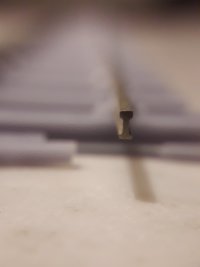@Gt.shefford
Hi Jonathan,
Welcome to Templot Club.

Well done on making your first piece of plug track.
Any thoughts on possible setting changes to dial out this inward cant?
This is where you are jumping ahead of me on what is still a very experimental project. I do have several thoughts on the subject, but which of them would be correct needs me to handle the track and get a feel for what's happening.
Writing a proper reply to your question is going to take me an entire evening or even a whole day. This is why this project is getting too much for me -- the endless explaining needed is more than I can manage.
There is a whole User Manual to be written on using plug track and getting the best results from it. But that requires a lot more progress with the programming, and then a long period of trial and testing, and reports from users. The results I get here with my own printers are generally good, and I use the settings as the defaults in the program. But every time I release a program update I have usually made a tweak here or there in some of the dimensions. Whether others are getting the same results from their machines I have no way of knowing.
The first question to ask about the non-upright rail is how firmly is it held between the key on the outer jaw and the grip part of the inner jaw? If there is any significant sideplay, the chairs need tightening up a little. There are at least 3 possible ways of doing that:
1. increase the exposure time in the printer. The need for that can be discovered by measuring some known part of the chair. Bear in mind that it will also make the loose jaw pin fit closer in its slot, so don't do it if there is no detectable play there.
2. reduce the web thickness setting in the rail section dimensions, or use the tweaking adjustment box on the
rail tab.
On the other hand if the rail is a tight fit in the chair, it probably needs easing a little. Not least because that might lead to stress-cracking of the chair over time.
3. change the fish angle and fish intersection dimensions for a better fit to your rail. Also if the rail-foot is wider than the rail-head, make sure this is reflected in the custom chair settings.
One reason for open-sourcing the code recently is so that folks can see what's happening and possibly suggest where I can make improvements. The default EMGS rail section dimensions in the program have been taken from some 10-year-old nickel-silver rail from the EMGS. How well this matches current steel rail from C&L I have no way of knowing. The dimensions can be seen in
dxf_unit.pas and here they are:
Code:
// model rail section over-rides ...
// C&L / EMGS / Exactoscale code75 bullhead. including some 3D printing allowances ...
if dxf_form.emgs_75_rail_radiobutton.Checked=True
then begin
rail_section_option:=1;
// convert to full-size at 4mm/ft and back to current scale (4mm/ft = *3" per mm)
rail_depth_mm:=1.90*3*inscale; // code 75 // - 2D TEMPLATE SETTING MAY DIFFER (cpi.rail_height_pi - inclined rail calcs - in inches)
rail_head_width_mm:=0.90*3*inscale; // - 2D TEMPLATE SETTING MAY DIFFER (cpi.railtop_pi - in mm)
rail_corner_rad_mm:=0.15*3*inscale;
rail_foot_width_mm:=0.90*3*inscale;
rail_fish_angle:=1.5; // 1:n arbitrary
rail_web_top_mm:=0.80*3*inscale; // from rail top to intersection fish angle on rail centre-line
rail_web_bottom_mm:=1.25*3*inscale; // from rail top to intersection fish angle on rail centre-line
rail_web_thick_mm:=0.35*3*inscale;
fish_calcs;
end;
If you can bear with me I will write again in a day or two.
cheers,
Martin.



 Search
Search

